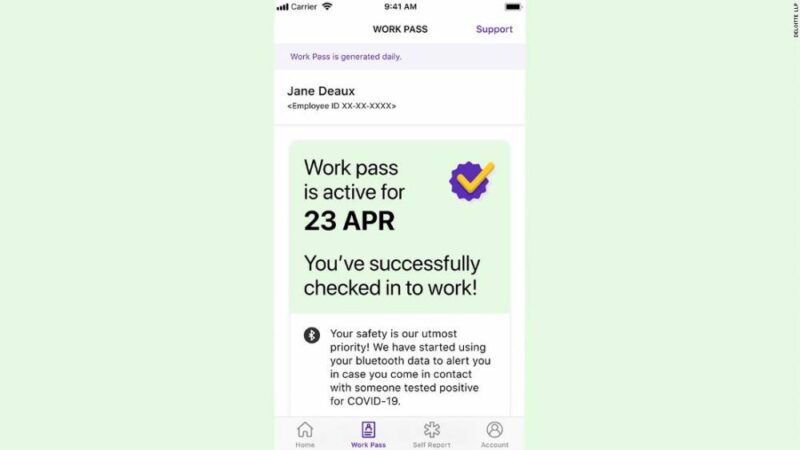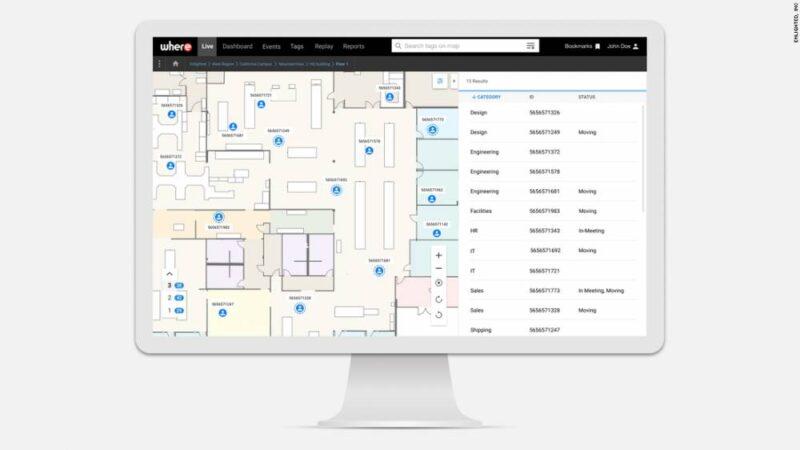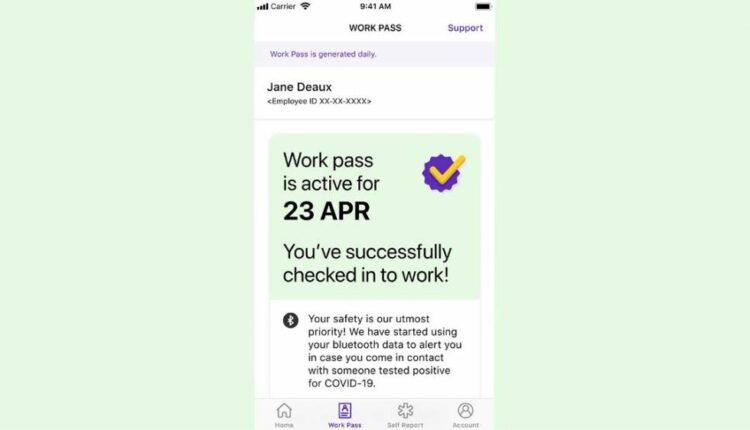As more workers return to the office, companies are considering ways to track their employees to help prevent the spread of coronavirus among their workforce.
“Employers are trying to understand how they reopen, and it’s going to vary by different companies,” said Todd Lohr, principal, digital enablement leader at KPMG. “They look at contact tracing as one of the elements for how you can manage bringing people back in a safe and measured way.”Companies may require you to check-in before entering the building, he said. That could mean being subject to a daily temperature check. Or answering a set of questions every morning like: Have you been diagnosed in the last 24 hours? Are you experiencing any Covid-19 symptoms? Have you been potentially exposed?

Some employees might be required to check-in via an app to verify they are healthy before entering the office. If you answer all the questions satisfactorily and you aren’t running a fever, you could be given a specific code or identifier that you show or scan at the front door to be allowed into the building. If you fail on either of those fronts, your badge could be deactivated. But the process won’t be over once you are in the office. Your employer is still going to want to know your whereabouts throughout the work day. Contact tracing relies on an accurate history of who an infected person had contact with and where they might have been in the office. Read MoreBut how companies will track employees will vary. Here are some of the methods they may use:
Your cell phone
Apps can be added to workers’ phones to monitor their movements as well as create notifications when social distancing isn’t being adhered to between colleagues.”Companies can leverage on managed devices, or even with other third-party applications, can get that GPS data to be able to say that [an employee] was in the office, because this is where we captured that data and here’s all the other employees who were in the office that day,” said Lohr.But GPS data is not always exact — especially for workers in high-rise buildings. “Based on the cell towers, it might think you are across the street or even down the block,” he said. “It’s not perfect precision, but for a lot of organizations that data is accessible today.”
Your laptop
When you log into a laptop and onto a virtual private network (VPN) it captures your location data, explained Lohr.”You are actually opening your laptop and you are pinging your network essentially for your employer and it is also using location information, so it knows where you are,” he said.A lot of companies hadn’t been capturing this data before because they didn’t have a need for it, he added.”Companies are now starting to think about what is the data I can capture with the things that I have.”
Your badge
Many workplace ID badges use radio frequency identification (RFID), which can track their wearer. Here’s how it works: Companies would have to place beacons, which are wireless transmitters, around the office to communicate with the badges, explained Brett Davis, general manager for ConvergeHealth at Deloitte. But RFID technology does come with risks. “RFID is not a ‘safe’ communication channel, so organizations should be extremely careful in what data is transmitted by these methods and what opportunities exist for subversion,” said Deborah Golden, cyber risk services leader for Deloitte Risk & Financial Advisory.
Wearables
Wearables, such as a wrist band or a device that attaches to your belt or hangs around your neck, can help with tracing and social distancing in the office. These devices could use networks within an office building that could show if you were within a few feet of someone or something, according to Lohr. “When the bands are within a certain distance of each other on the employees’ wrist…that data is collected and can be transmitted to a phone or other device so that the data about who was close to whom for what period of time can be stored,” said Davis.Existing wearables could also help with contact tracing. “Your Apple watch could become a beacon just like your phone could be,” said Lohr.
Light sensors
Many newer buildings are equipped with light sensors to help reduce energy costs by doing things like turning off the lights in a room if there is no activity for a while. But light sensors can also be used to track the movement of employees. Silicon Valley-based company Enlighted makes Bluetooth-enabled smart sensors that attach to LED lights that can provide location-based tracking. The Bluetooth receivers can track beacons placed on various objects. For instance, some hospitals tag wheelchairs to help staff easily find them.

By using sensors, Enlighted can provide employee location and digital contact tracing These sensors can help track employees in real time in two ways: ID badges equipped with Bluetooth beacons or smartphones equipped with an app that allows it to create signals. “The phones need the user to download an application and specifically allow it to beacon,” said Tanuj Mohan, Enlighted’s founder and chief technology officer.
Privacy concerns
There are privacy and legal concerns when it comes to collecting and storing data like this.”Obviously, with the data … around that personal information and personal health information it brings in significant privacy and data protection implications,” said Golden. “Not only just gathering it, but it’s going to be gathered, it’s going to be stored, it’s going to be manipulated, it’s going to be analyzed.”Companies need to find the right balance between creating a safe workspace and using whatever tools are available to them and making sure they are complying with the laws and respecting their employees’ privacy,” said Jena Valdetero, a partner at law firm Bryan Cave Leighton Paisner, who also co-leads the firm’s Data Privacy and Security Team. “We will be asking people to do things that we’ve never asked them to do before.” said Valdetero.Companies need to make sure there are processes in place to maintain the privacy of employees, she added. Using a unique identification number when tracking can help keep a level of privacy.”The best thing to do is limit the number of people within the organization who has access to the information and wherever it is stored it is in a secured manner,” she said.And when it comes to using third-party apps on their phones, employers need to thoroughly vet them: Understand exactly how the data is being collected, used and shared, what security measures are in place and who owns the information.”I’d be wary of using a free app,” said Valdetero.Employers also need to be transparent about how they might use the information outside of Covid-19 tracing. For instance, what if the tracking shows a worker napping or being in areas of the office they are not supposed to be in? “It raises an interesting enterprise between employment law and privacy law. There are definitely employment laws, particularly the Americans with Disabilities Act, that dovetail right into these issues,” said Valdetero
Privacy laws vary by state. For instance, under the California Consumer Privacy Act, some businesses have to give notice to state employees about what personal information they are collecting and how it’s going to be used.”There have been some loosening of requirements somewhat since this is a global pandemic,” Valdetero said. “There is a bit more that companies can require people to do.”
Source: edition.cnn.com

